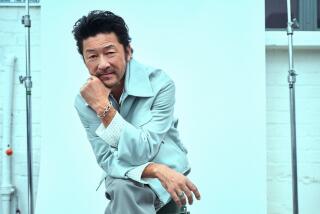Recognition for reserved vet
Like many World War II veterans, he speaks modestly about his service.
He is quiet and a polite listener, not the kind to draw attention to himself. But a few months ago, as he visited the National WWII Museum in New Orleans, other veterans noticed his hat emblazoned with his unit’s insignia and number.
“You see him?” someone asked. “He was in the 442. I’ve read about them.”
Another vet, after spying the hat, walked up to him. “Sir, I just want to shake your hand.”
The 442 refers to the 442nd Regimental Combat Team, one of the all-Japanese American units that served with distinction in World War II. The unassuming man turning heads was my father-in-law, Tokuji Yoshihashi.
I couldn’t help but smile as people sought him out and asked questions. They remembered the story of the 442 -- often known for its motto “Go for Broke” -- and that’s a comfort. “Toke,” as the family calls him, is a living reminder of the sad but triumphant story of the Nisei, or second-generation Japanese Americans, who overcame the Axis abroad and prejudice at home.
I’ve heard the story again and again and it still defies reason, still offends. Toke was among more than 110,000 Japanese Americans thrown into internment camps amid racist wartime hysteria. Forced out of their Pasadena home, Toke and his family ended up at the sweltering Gila River camp in Arizona.
Then the nation that had spurned them wanted the Nisei men to fight, so Toke and his older brother, Ichiro, shipped off to Europe. Toke makes a point of saying he was drafted.
Over the years, he’s shared stories: About throwing away a heavy coat, only to regret it when the weather turned cold; about seeing Italians hitting and spitting on Mussolini’s corpse after it was strung up by the ankles in Milan; about how he and fellow Nisei soldiers traveling through New Orleans tracked down a Chinese restaurant because they missed gohan, rice. A kind stranger picked up their tab.
And he’s also spoken of that grand day in Washington, when the Nisei marched down Constitution Avenue past President Harry S. Truman. “You fought not only the enemy, but you fought prejudice -- and you have won,” Truman said.
In time, he married, settled in San Gabriel, raised three children and worked for the Department of Water and Power as a mechanic. With dignity and hard work, he showed Truman was right. Toke was in Washington again in 2011 when congressional leaders awarded the Congressional Gold Medal, the nation’s highest civilian honor, to the three Nisei units -- the 442nd, the 100th Infantry Battalion and the Military Intelligence Service.
He and other veterans traveled to New Orleans in January for the launch of a touring Smithsonian Institution exhibit about the medal, which eventually will go on permanent display at the Smithsonian in Washington. Eric K. Shinseki -- a retired four-star general, former chief of staff of the Army and now secretary of Veterans Affairs -- spoke at a luncheon there and looked out at the old men. Shinseki, a third-generation Japanese American, or Sansei, was born in 1942, the year the internment camps were opened.
“I am one of the beneficiaries of the men in this room,” he said.
As Shinseki noted, the three units are among the most highly decorated in U.S. military history, with more than 4,000 Purple Hearts, seven presidential unit citations and 21 Medals of Honor, the nation’s highest military honor. “There are units that fought in the Revolutionary War that don’t have such credentials,” he said.
The gold medal features rows of Nisei soldiers at attention and, on the back, the emblems of the three units. It now has come to the Japanese American National Museum in Little Tokyo -- it’s on display till June 9 -- and perhaps its presence will prompt Angelenos to reflect not just on the veterans’ wartime service, but on another enduring part of their legacy.
The march toward greater civil rights has never followed a single path. The suffragettes made their contributions, so did Rosa Parks, so did the Nisei, so did untold others. One can’t say all are directly linked, but in a larger sense, they collectively created the country we know today.
That thought ran through my head last June as I watched replicas of the gold medal awarded to veterans or their survivors at the Go For Broke Monument in Little Tokyo. Among those presenting the medals as the names of the soldiers were read aloud to sustained applause were three Southern California congresswomen -- Maxine Waters, Lucille Roybal-Allard and Judy Chu.
Think of it. The first black congresswoman was not elected until 1968; the first Latino congresswoman, 1989. Chu became the first Chinese American woman elected to Congress just four years ago.
Three women, three minorities, three members of Congress. Such a thing was unimaginable when Toke and his fellow Nisei soldiers went off to war.
--
More to Read
Sign up for Essential California
The most important California stories and recommendations in your inbox every morning.
You may occasionally receive promotional content from the Los Angeles Times.










